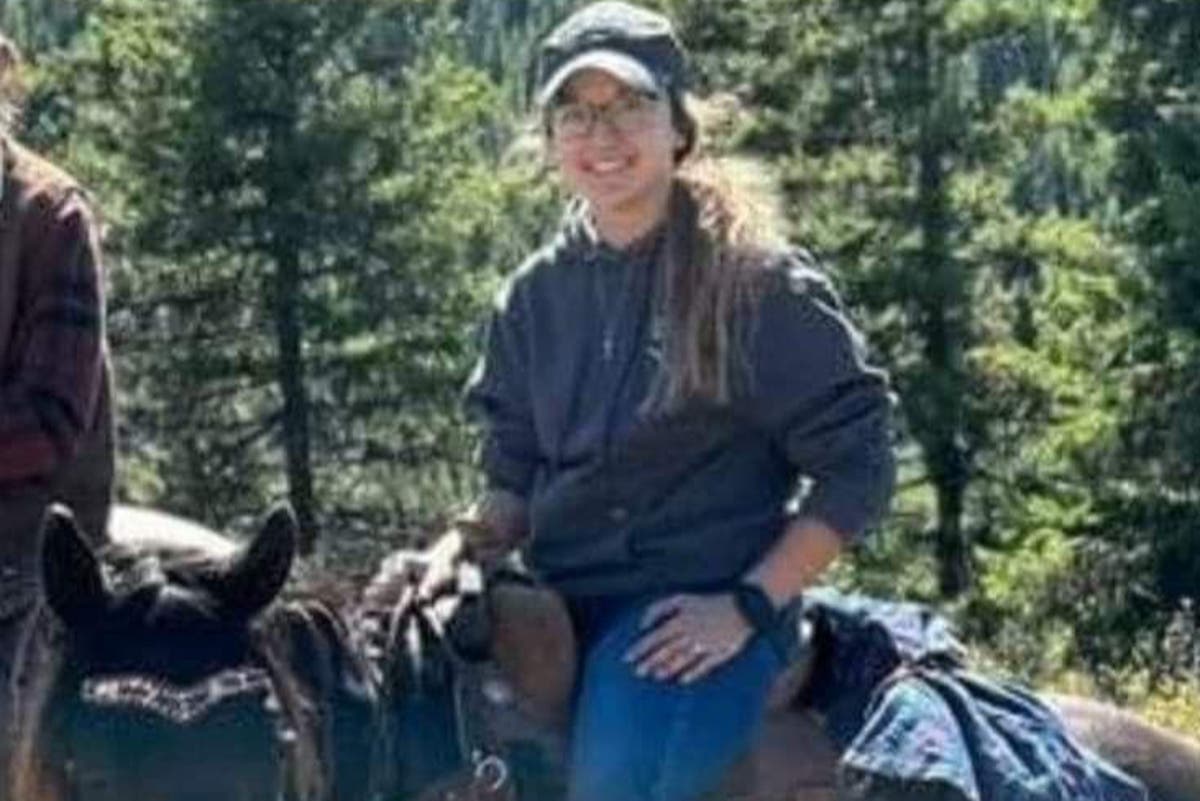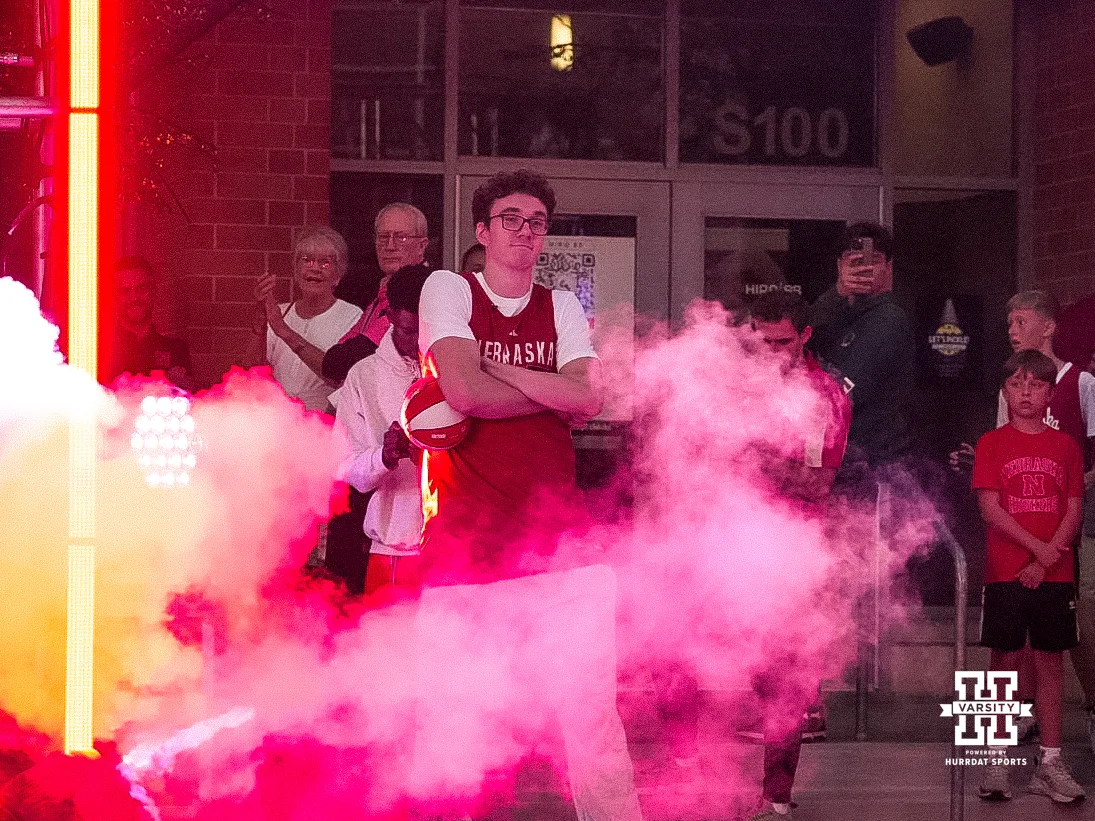Lifestyle
Lynx, tiger and tadpoles, oh my: See the Wildlife Photographer of the Year winners

Winner, The Bigger Picture, Wetlands: The Swarm of Life by Shane Gross, Canada. Western toad (Anaxyrus boreas) tadpoles swim among lily pads in a lake on Vancouver Island, British Columbia.
Shane Gross/Wildlife Photographer of the Year
hide caption
toggle caption
Shane Gross/Wildlife Photographer of the Year
They lay in wait for hours, weeks and sometimes months, tracking animals in the wild and moving carefully so as not to disturb their surroundings.
They set up their camera traps, framed their shots and seized the moment — from a lynx stretching in the sunshine and a young monkey sleeping in an adult’s arms, to an anaconda wrestling with a yacare caiman and a falcon hunting a butterfly.
Now, thanks to those efforts, they are officially the 2024 Wildlife Photographers of the Year.
London’s Natural History Museum, which runs the prestigious competition, announced the winners of its 18 categories — from underwater to urban wildlife — at a ceremony on Tuesday. The museum narrowed down the winners from a record-breaking pool of 59,228 entries from 117 countries.
The winners will be featured in an exhibition at the Natural History Museum that opens Friday and runs through June, and will also tour internationally to venues across Europe, Canada and Australia. It will also include winners and photographic equipment from years past in honor of the contest’s 60th anniversary.
Museum Director Doug Gurr called the contest’s longevity “a testament to the vital importance and growing appreciation of our natural world.”
“We are delighted to feature such inspiring images in this year’s portfolio,” he said in a statement. “These are photographs that not only encourage further wildlife conservation efforts, but that spark the creation of real advocates for our planet on a global scale.”
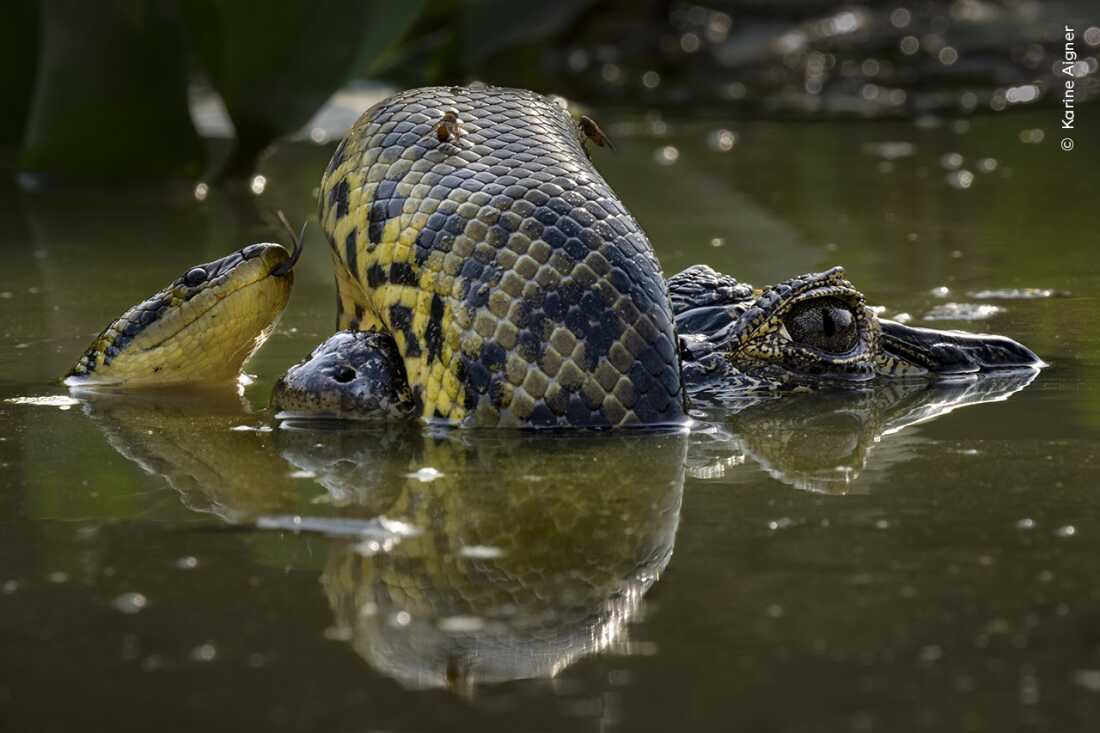
Winner, Amphibians and Reptiles Behavior: Wetland Wrestle. Transpantaneira Highway, Mato Grosso, Brazil. Karine Aigner recognizes the skin of a yellow anaconda as it coils itself around the snout of a yacare caiman.
Karine Aigner/Wildlife Photographer of the Year
hide caption
toggle caption
Karine Aigner/Wildlife Photographer of the Year
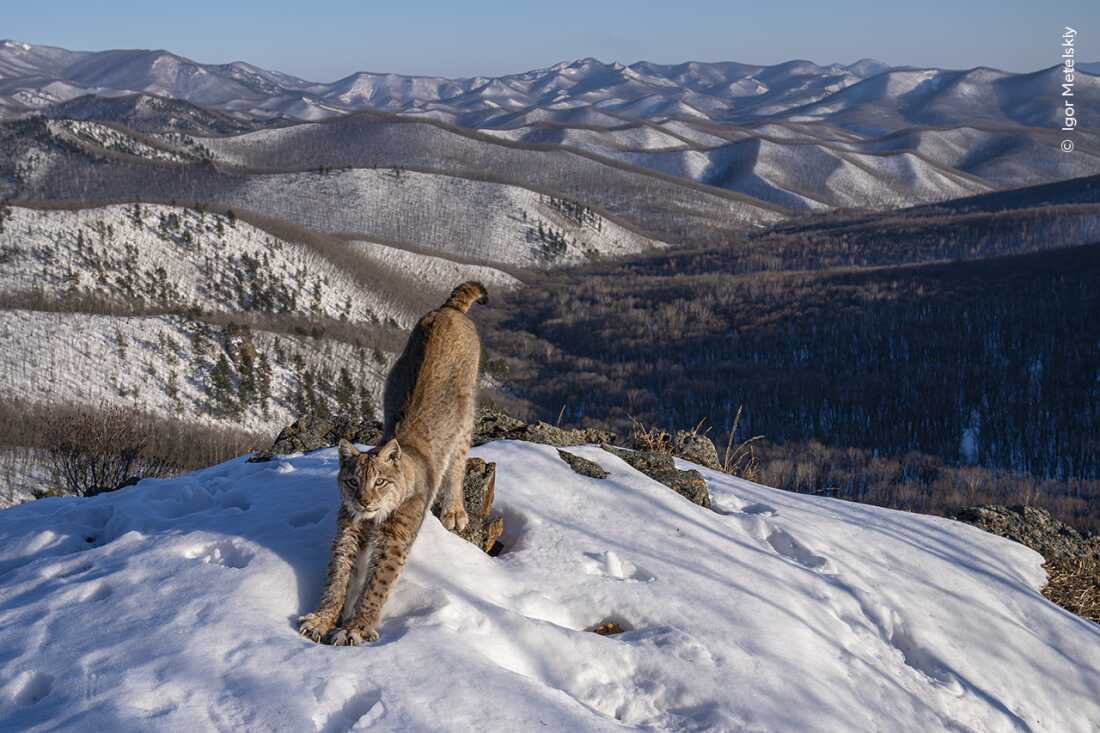
Winner, Animals in their Environment: Frontier of the Lynx by Igor Metelskiy, Russia. Metelskiy shows a lynx stretching in the early evening sunshine, its body mirroring the undulating wilderness.
Igor Metelskiy/Wildlife Photographer of the Year
hide caption
toggle caption
Igor Metelskiy/Wildlife Photographer of the Year
An international panel of expert judges chose two grand title winners from among the 18, based on the entries’ “originality, narrative, technical excellence and ethical practice.”
The grand title of Wildlife Photographer of the Year went to Shane Gross, a Canadian marine conservation photojournalist who spent several hours underwater documenting western toad tadpoles on the move.

Gross snorkeled painstakingly through carpets of lily pads in Cedar Lake on Vancouver Island, British Columbia, careful not to disturb the layers of silt and algae at the bottom. He was able to snap the tadpoles as they swam up from the depths, dodging predators on their way to feed at the surface.
He titled the stunning scene The Swarm of Life.
“The jury was captivated by the mix of light, energy and connectivity between the environment and the tadpoles,” said jury chair and editor Kathy Moran, noting that the tadpoles are a species new to the winning archive.
Western toads are considered either endangered or threatened in parts of Canada and the U.S., due to habitat destruction and predators. The tadpoles begin their transition into toads between four and 12 weeks after hatching, but an estimated 99% of them will not survive to adulthood.
“I hope the attention this image brings our amphibians and wetlands leads to much-needed and urgent protections,” Gross posted on Instagram after his win. “If you know of an important place in your backyard, let’s rally the community together and fight for [its] protection.”
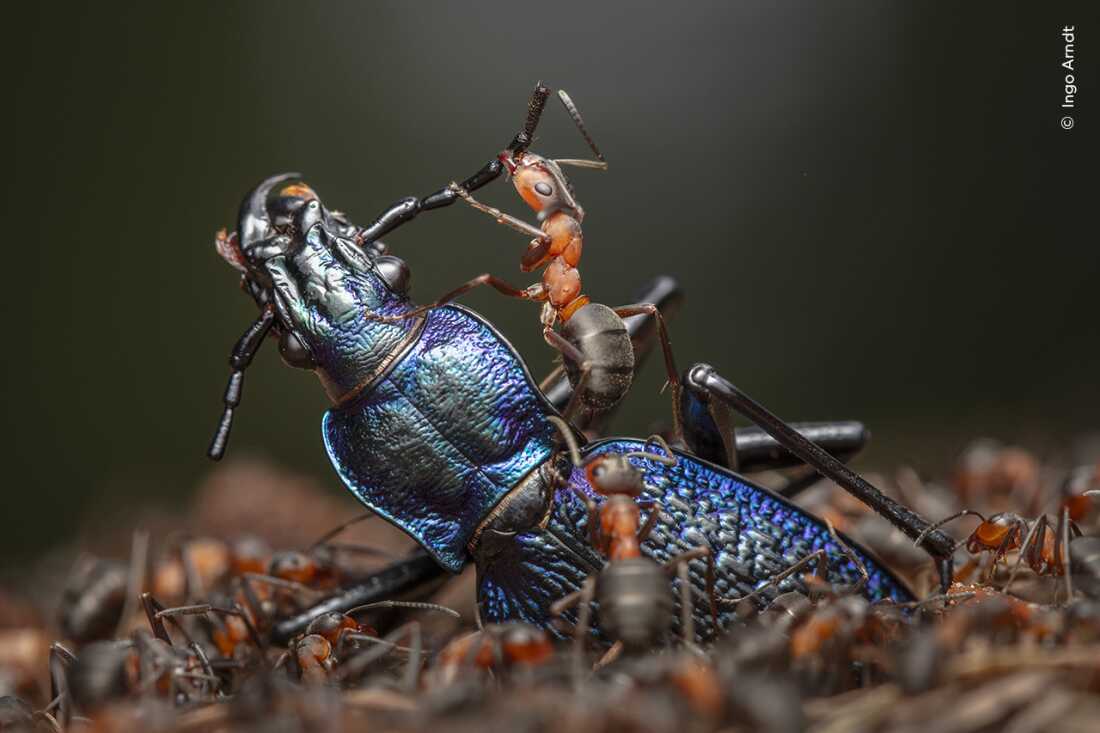
Winner, Invertebrates Behavior: The Demolition Squad by Ingo Arndt, Germany. Arndt documents the efficient dismemberment of a blue ground beetle by red wood ants.
Ingo Arndt/Wildlife Photographer of the Year
hide caption
toggle caption
Ingo Arndt/Wildlife Photographer of the Year

Winner, The Bigger Picture, Oceans: A Diet of Deadly Plastic by Justin Gilligan, Australia. Gilligan creates a mosaic from the 403 pieces of plastic found inside the digestive tract of a dead flesh-footed shearwater.
Justin Gilligan/Wildlife Photographer of the Year
hide caption
toggle caption
Justin Gilligan/Wildlife Photographer of the Year
Many of the winning images draw attention to the threats facing different species around the world: a mosaic made of over 400 pieces of plastic found inside the digestive tract of a dead shearwater, a type of Australian seabird; a tiger perched on the hillside overlooking an Indian town that was once a forest; a crime scene investigator dusting a confiscated tusk for prints.

The Young Wildlife Photographer of the Year award went to teenager Alexis Tinker-Tsavalas of Germany for his image Life Under Dead Wood, which shows the tiny, fruiting bodies of slime mold (a type of single-cell organism) and a springtail (a non-insect hexapod) beneath a log.

Winner, 15-17 Years: Life Under Dead Wood by Alexis Tinker-Tsavalas, Germany. Springtails and slime molds are two of Alexis’ favorite macro photography subjects.
hide caption
toggle caption
Alexis moved fast, rolling the log over and snapping away quickly, since springtails “can jump many times their body length in a split second,” the judges wrote.
He used a technique known as focus stacking, combining 36 images — each with a different area in focus — to make one image with an even greater depth of field.

“A photographer attempting to capture this moment not only brings great skill, but incredible attention to detail, patience and perseverance,” Moran said. “To see a macro image of two species photographed on the forest floor, with such skill, is exceptional.”
Slime mold and springtails may not be as widely known as some of the other subjects of the winning photographs, like ants and a hawk. Alexis told the BBC that he hopes people will learn more through his images.

Winner, Underwater: Under the Waterline by Matthew Smith, UK/Australia. This was Smith’s first personal encounter with a leopard seal.
Matthew Smith/Wildlife Photographer of the Year
hide caption
toggle caption
Matthew Smith/Wildlife Photographer of the Year

Winner, Mammals Behavior: A Tranquil Moment by Hikkaduwa Liyanage Prasantha Vinod, Sri Lanka. Vinod finds this serene scene of a young toque macaque sleeping in an adult’s arms.
Hikkaduwa Liyanage Prasantha Vinod/Wildlife Photographer of the Year
hide caption
toggle caption
Hikkaduwa Liyanage Prasantha Vinod/Wildlife Photographer of the Year
“I feel like that’s one of the biggest goals for me, to just show this tiny world that a lot of people don’t really get to see, in a different light,” he said.
Entries for the next edition of the contest will be accepted from Oct. 14 through Dec. 5. In the meantime, take a look at more of this year’s crop of winners.

Winner, Birds Behaviour: Practice Makes Perfect by Jack Zhi, Los Angeles. A young falcon practices its hunting skills on a butterfly above its sea cliff nest.
Jack Zhi/Wildlife Photographer of the Year
hide caption
toggle caption
Jack Zhi/Wildlife Photographer of the Year

Winner, Photojournalism: Dusting for New Evidence by Britta Jaschinski, Germany/UK. Jaschinski watches as a crime scene investigator from London’s Metropolitan Police dusts for prints on a confiscated tusk.
Britta Jaschinski/Wildlife Photographer of the Year
hide caption
toggle caption
Britta Jaschinski/Wildlife Photographer of the Year

Highly Commended, Mammals Behaviour: Don’t Look Down by Rick Beldegreen, Torres del Paine National Park, Chile. A group of puma cubs stalks their potential guanaco prey.
Rick Beldegreen/Wildlife Photogprapher of the Year
hide caption
toggle caption
Rick Beldegreen/Wildlife Photogprapher of the Year

Winner, Plants and Fungi: Old Man of the Glen by Fortunato Gatto, Italy. Gatto comes across a gnarled old birch tree adorned with pale “old man’s beard” lichens.
Fortunato Gatto/Wildlife Photographer of the Year
hide caption
toggle caption
Fortunato Gatto/Wildlife Photographer of the Year

Winner, 11-14 Years: An Evening Meal by Parham Pourahmad, Ed R Levin County Park, Calif. Parham watches as the last rays of the setting sun illuminate a young Cooper’s hawk eating a squirrel.
Parham Pourahmad/Wildlife Photographer of the Year
hide caption
toggle caption
Parham Pourahmad/Wildlife Photographer of the Year

Lifestyle
Donald Trump Says He's 'Basically a Truthful Person,' Podcaster Laughs in Face

FLAGRANT
Donald Trump says he’s got some Pinocchio in him … saying he’s “basically a truthful person” during a podcast interview — and, the statement had one podcast host laughing in his face.
The 45th POTUS stopped by “Andrew Schulz’s Flagrant with Akaash Singh” podcast … and, he launched into a discussion of the ads his presidential opponent Kamala Harris is running — saying they’re full of falsehoods about him.
DJT says Kamala’s team is twisting his views on IVF and his use of the word “bloodbath” when discussing the economy in new TV ads … saying it’s all come out as an unfair depiction of him.
Trump says there should be a law against telling lies in campaign ads … before adding he doesn’t lob similar attacks at his opponent ’cause he’s “basically a truthful person.”
At this, Andrew Schulz busts up laughing … asking the Republican candidate for president what that means. It seems he’s laughing more at the phrasing than any sort of incredulity of the statement — but, it still makes for a pretty funny moment.
Former American President Donald Trump, in the Flagrant podcast, describes Prime Minister Modi as the nicest human being but also a total killer.
He added that Modi took him by surprise with his threat of aggressive retaliation against Pakistan when he said we would handle them;… pic.twitter.com/8oOH9ELvx3
— BJP (@BJP4India) October 9, 2024
@BJP4India
Trump also talked foreign policy on the show … and, his comments about Prime Minister Narendra Modi — who he calls one of the nicest guys who also showed him a potentially violent side from time to time — are receiving mixed reactions online.
The election’s in less than a month … and, Trump’s promoting himself as the “basically” truthful candidate.
Lifestyle
We talk SNL, late night TV, and the 2024 election : Pop Culture Happy Hour

Lifestyle
These are the most fascinating L.A. museums you've never heard of

Todd Lerew is curious. He likes lists. And he doesn’t like doing things halfway.
This is why he collects pictorial maps, why he has visited 248 public libraries in Los Angeles County and 401 of the 483 municipalities in California. It’s why he recently joined the Fraternal Order of Eagles, the Elks, Moose International, Oddfellows and about 50 other clubs — so many that he had to get a separate wallet for membership cards.
This may seem like a lot of projects for one 37-year-old, who calls them “acts of compulsive nerdiness.” But those interests pale next to Lerew’s passion for unsung museums and collections.
That’s the subject of his new book, “Also on View: Unique and Unexpected Museums of Greater Los Angeles,” published this week by Angel City Press at Los Angeles Public Library.
The volume, an illustrated exploration of 64 museums whose names you are unlikely to know, draws on a decade of research and stands as a challenge to all Angelenos who think they have a handle on the local cultural landscape.

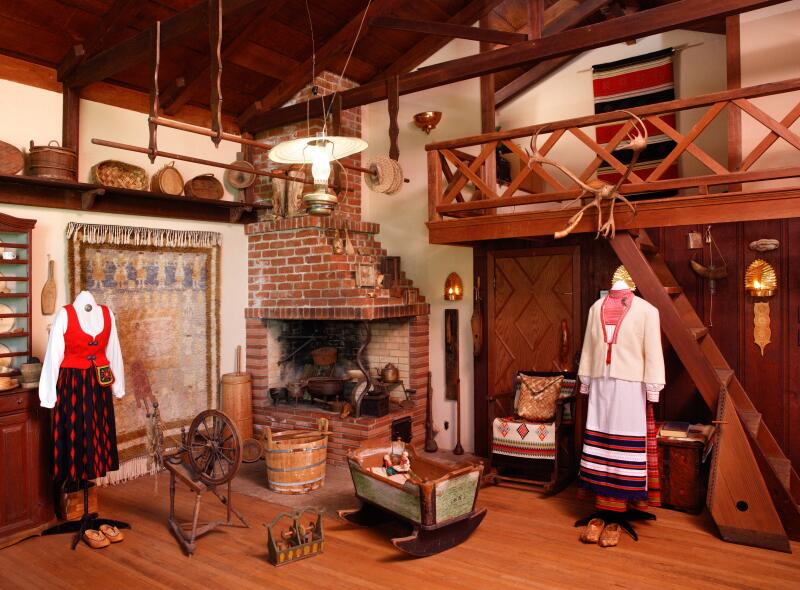
Skid Row History Museum & Archive, from top; Skateboarding Hall of Fame Skateboard Museum in Simi Valley; and Finnish Folk Art Museum in Pasadena. (Ryan Schude)
These are ventures — often one-person crusades — that celebrate fast food, Finnish folk art, Skid Row, skateboarding, vertebrate zoology and more. Yes, the Museum of Jurassic Technology in Culver City is here. Yes, the U.S. Navy Seabee Museum in Port Hueneme and the Cucamonga Service Station Museum too.
The Museum of the Republic of Vietnam in Westminster? The Parsonage of Aimee Semple McPherson in Echo Park? The Historical Glass Museum in Redlands? Lerew and photographer Ryan Schude visited them all.
“There’s nothing you can say about museums that’s true of all of them,” Lerew said one recent morning. “And you can find them everywhere you look.”
Indeed, he spoke near the Long Beach waterfront, surrounded by unremarkable skyscrapers and zero foot traffic. But a block away stands the Outer Limits Tattoo and Museum, opened in 1927.
This was first of two stops where Lerew planned to deliver copies of the new book to people who are in it.
The oldest operating tattoo shop in the U.S.




Clockwise from top left, at Outer Limits Tattoo and Museum in Long Beach: veteran tattoo artist Kari Barba, tattoo designs on display, a jacket from Bert Grimm’s Famous Tattoo Studio and a display case of flash and tools. (Ryan Schude)
Inside Outer Limits, founder and tattoo artist Kari Barba, 64, eagerly unwrapped a copy of the book. Barba, a celebrated tattoo artist and industry pioneer who runs a second tattoo location in Costa Mesa, said she bought the Long Beach space 20 years ago because “I was really hurt by the idea that the history of the building would be lost.”
Barba led Lerew and a visitor through the restored rooms; the tables and modern tools now in use; the antique tools; the stencils of anchors, hearts and dragons; the old photos of inked sailors at the long-gone Pike amusement park; a hand-painted window that workers found hidden in a wall; and, in one corner, a mysterious covered vat.
“You’ve got to see the vaseline before we go,” Lerew said.
So Barba and Lerew stepped to the vat and uncovered it, revealing a glutinous stew of rags and vaseline, once integral to the tattoo process; the stew’s age and precise contents are uncertain.
“I don’t know what’s in there. I’m not reaching in to find out,” Barba said.
“Distinctive smell, also,” said Lerew, leaning to sniff.
What shapes a compulsive collector?
Lerew, who lives with his wife in Lincoln Heights, grew up in rural South Dakota. His family made regular trips to roadside attractions such as the faux cowboy town at Buffalo Ridge and the Corn Palace in Mitchell, where something about “the curious, the unique and the obscure” got under Lerew’s skin.
After graduating from Hampshire College in Massachusetts, he came west in 2009 and went to grad school at CalArts, focusing on experimental music composition. But his attention strayed, a trait that became a professional asset when the Library Foundation of Los Angeles hired Lerew as program manager in 2015.
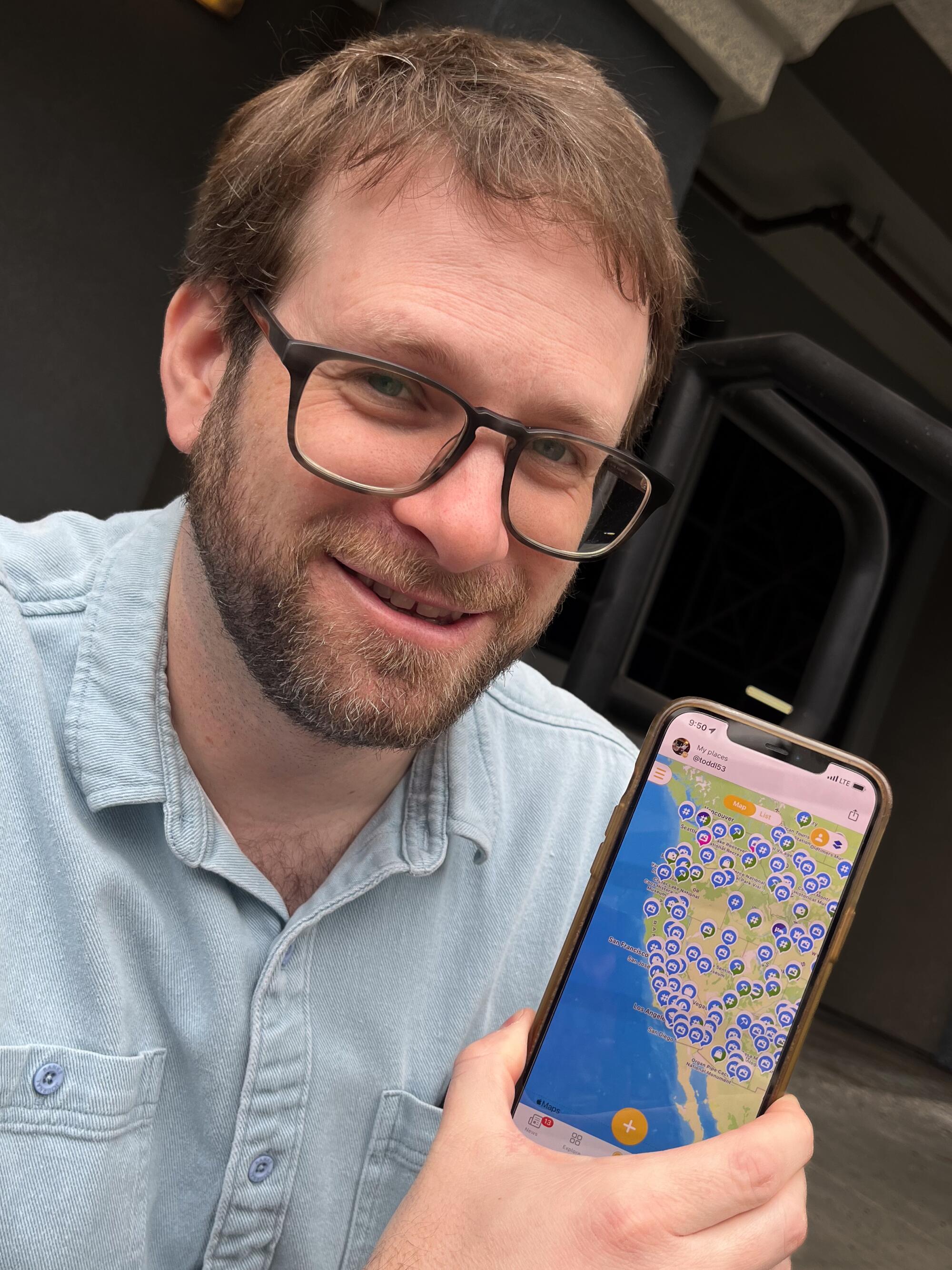
Todd Lerew, author of the book “Also on View,” about small and surprising museum in Greater Los Angeles, shows the map full of museum locations that he keeps on his phone.
(Christopher Reynolds / Los Angeles Times)
In his off hours, he’d check out other libraries and museums — often six or seven in a day, all logged on a spreadsheet. To find them all, he’d check Boris Stanic’s guidebook, “Museum Companion to Los Angeles,” as well as scanning the web and talking to friends and strangers.
In 2016, after months of hearing from Lerew about his weekend explorations of obscure collections and archives around Southern California, the foundation’s president, Ken Brecher, assigned Lerew to curate an exhibition on local collectors that became “21 Collections: Every Object Has a Story.”
“I’ve always collected experiences of one kind or another,” Lerew said. “I was just exploring because I had a private interest and obsession in finding new and unique places and people. It kind of got formalized when i started working on that exhibition.”
What makes a museum?
Lerew said he’s eager to see just about any place that calls itself a museum, whether or not it has nonprofit status or academic credentials or a permanent home. He’s also drawn to spaces that might not call themselves museums but often behave like them, including park visitor centers or college art galleries.
When it comes to selfie-driven exercises like the nationwide Museum of Ice Cream chain (which had an L.A. pop-up location in 2017), he’s not so interested.
And in every museum, he considers the source carefully. At most historical museums in the U.S., he said, “It’s the white people’s history of that area,” omitting much and perhaps whitewashing much else.
“You just have to be aware, when you’re going to these places, of who is telling the story,” he said. “There are more stories out there, always.”
By the time his “Collections” show went up in the Central Library in 2018, Lerew had scouted more than 600 locations, enlisting collections that included paper airplanes (from the Getty), typewriters (from Tom Hanks), candy wrappers and birds’ nests. From that project came a self-published book, an Instagram campaign (@museumaday) and now the new volume, coffee table-ready.
By hand, she re-creates key moments in Black history

A “Black Lives Matter” diorama created by Karen Collins.
(Ryan Schude)
“Oh, big pictures!” Karen Collins said when Lerew arrived at her home in Compton and handed her the book. “I don’t know why, but I was picturing something small.”
Small, after all, is Collins’ specialty. Around her living room, miniature dioramas of crucial moments in Black American history took up much of the horizontal space. A “Black Lives Matter” triptych, made for the Central Library’s “21 Collections” exhibition, sat above the fireplace.
Collins, 73, a retired preschool teacher, creates the dioramas, making and arranging miniatures within shadow boxes made by her husband, Eddie Lewis. She started about 30 years ago, after her son was sent to prison as a 12th-grader and she felt “ready to die.”
She pushed grief back by resolving to portray key figures and moments in Black history, to inspire and educate grade-school children, “and let them know, you can get over anything. … The art saved my life.”

Karen Collins and her African American Miniature Museum, a collection of Black history dioramas she made and keeps in her Compton home, are featured in “Also on View,” Todd Lerew’s book about small and surprising museums in Greater Los Angeles.
(Christopher Reynolds / Los Angeles Times)
There have been dozens of dioramas since then, depicting scenes from the Middle Passage to Harriet Tubman, Malcolm X, Martin Luther King Jr., Thurgood Marshall, Colin Powell, the Obama inauguration, Compton Cowboys and Kendrick Lamar.
For years, Collins and her husband brought shadow boxes — their mobile museum — to schools and community events. Lerew spotted her work on display in Leimert Park.
Lerew: “How many of these have you made over the years?”
Collins: “A lot. Because I give them away.”
Beyond Lerew’s Central Library exhibition and book, Collins has been commissioned by the Autry Museum (where several dioramas are part of the permanent exhibition “Imagined Wests”), profiled by national media outlets and chosen to provide a Google doodle for the 60th anniversary of the Greensboro, N.C., civil rights sit-ins. Her son, still incarcerated, “is proud of me,” she said.
Now she’s working on a coloring book and hoping to find “a stable place for this museum to be … for our children to see their worth,” she told Lerew.
“It’s a really tricky thing,” Lerew said later, “when it’s one person’s passion project. … I can’t say what might happen for Karen’s collection. I have hopes. Time will tell.”
Is Lerew done with little museums now? Absolutely not.
Beyond those in the book, he’s put another 700-plus large and small Southern California museums onto an everymuseum.la website, now live.
Then there’s the other list on his phone, where he has keyed in all the unseen museums he wants to visit. Worldwide. There are 3,231 of them.
-
/cdn.vox-cdn.com/uploads/chorus_asset/file/25439572/VRG_TEC_Textless.jpg)
/cdn.vox-cdn.com/uploads/chorus_asset/file/25439572/VRG_TEC_Textless.jpg) Technology7 days ago
Technology7 days agoCharter will offer Peacock for free with some cable subscriptions next year
-

 World6 days ago
World6 days agoUkrainian stronghold Vuhledar falls to Russian offensive after two years of bombardment
-

 World6 days ago
World6 days agoWikiLeaks’ Julian Assange says he pleaded ‘guilty to journalism’ in order to be freed
-

 Technology6 days ago
Technology6 days agoBeware of fraudsters posing as government officials trying to steal your cash
-

 Health4 days ago
Health4 days agoHealth, happiness and helping others are vital parts of free and responsible society, Founding Fathers taught
-

 Virginia1 week ago
Virginia1 week agoStatus for Daniels and Green still uncertain for this week against Virginia Tech; Reuben done for season
-

 Sports5 days ago
Sports5 days agoFreddie Freeman says his ankle sprain is worst injury he's ever tried to play through
-

 News4 days ago
News4 days agoLebanon says 50 medics killed in past three days as Israel extends its bombardment
